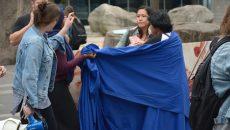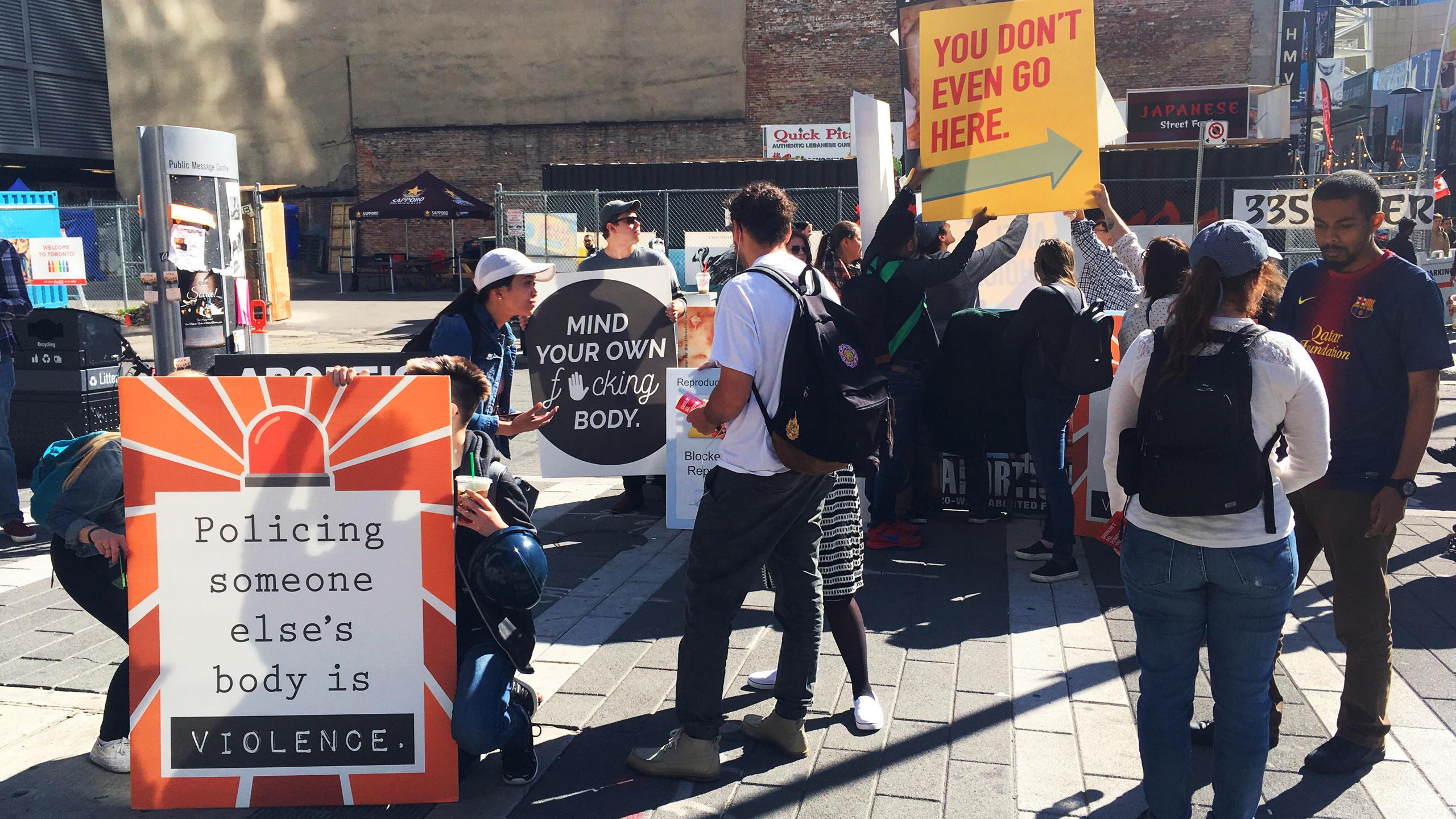By Alanna Rizza and Sarah Krichel
Anti-choice protesters plan to display their graphic signs on Ryerson campus until 2030—and some of them are being paid to do it.
According to Blaise Alleyne, president of Toronto Against Abortion (TAA) and outreach coordinator for the Canadian Centre for Bio-Ethical Reform (CCBR), as many as a dozen protesters are being paid to stand on Ryerson campus as part of a campaign to start discussion and debate on reproductive rights.
The 18-year campaign, which is a collaboration between TAA and CCBR, began in 2012. The first major goal is to have every Torontonian see their graphic images by 2020. TAA and CCBR have similar plans in place for Calgary and Vancouver, and hope to eventually spread their movement across Canada by 2030.
Ryerson students were first exposed to the anti-choice signs on campus at the beginning of last school year.
“We’ll be here for years. We’re in this for the long haul,” Alleyne said.
Their graphic images of dead fetuses can cause a lot of harm to people affected by abortion. The Eye has heard multiple accounts of unwanted altercations between the protesters and passerbys, such as being told “You should have been aborted,” and “Did you just misgender me?” when speaking to trans people, mockingly.
Alleyne is one of many CCBR employees paid for protesting on campuses. TAA does have paid staff but they are primarily made up of volunteers. CCBR accesses volunteers from TAA, who assist with outreach and activism.
Both CCBR and TAA are primarily funded by private donations. Since they are non-profit organizations they can also apply for grants.
Alleyne declined to provide The Eye with further information regarding the funding and costs for the campaign or how much staff get paid.
The counter-protests from the Ryerson Students’ Union (RSU) equity centre staff and volunteers eventually sparked the creation of Ryerson’s Reproductive Justice Collective (RRJC) in November 2016. The RRJC campaigned for the removal of these protesters on campus.
In the fall of 2014, an anti-choice student group called Students for Life at Ryerson (SFLR) attempted to get ratification to receive funding. The RSU denied the request on the basis of being opposed to groups that promote “misogynist views” and challenge bodily autonomy. SFLR took the RSU to court in December 2015, but the case was dismissed.
“We will be here for years. We’re in this for the long haul”
In 2016, the RSU’s former vice-president equity Tamara Jones, in collaboration with the RRJC called for town halls and round table discussions, but no solution was reached. The university’s hands were tied since Gould Street is city property and Ryerson security has no authority to ask the protesters to leave. Jones then reached out to city councillor Kristyn Wong-Tam to gain stewardship rights over Gould Street, but nothing came of it. The only real solution was to call Toronto police.
While Ryerson continued to say “there isn’t much we can do,” other campuses such as Sheridan and Mohawk colleges had an email system that would notify students when anti-choicers are scheduled to be on campus.
This school year, the RRJC has an application process to bring more volunteers to the collective. They have started an email list to notify students when anti-choicers are on campus as well as to suggest alternate routes around campus.
“Something that the RRJC wants to focus more on this year is having a more proactive approach opposed to a reactive approach,” said Camryn Harlick, RSU vice-president equity and co-founder of the RRJC. Now, students can spot counter-protesters holding signs that read “Policing someone else’s body is violence,” and “Mind your own fucking business.”
“I think it’s bad that folks are being paid to purposely harm and stigmatize other students on this campus,” said Harlick. “We see the direct negative results it has on students— and that’s not enough for folks to see that their actions are harmful.”
Alleyne said post-secondary education campuses are “a major piece of the puzzle” to show that abortion is a “human rights violation.”
He said students are at a stage where they form opinions on controversial topics and are “at risk for abortion.”
Alleyne said that about 15 to 30 Ryerson students are volunteers and in different stages of training. The training for staff and volunteers includes “how to have the most effective conversation on abortion,” including how to respond to counter-protesters, specifically people shouting and swearing.

The RRJC started an email list to notify students when anti-choicers are on campus. Photo: Annie Arnone
Anti-choice activists are required to sign a code of conduct that attempts to ensure “a standard of professionalism.” It includes not being forceful or disrespectful including not swearing.
Alleyne says anti-choice protesters are trained to “respond with kindness,” but RRJC members say that the response isn’t always kind.
“I know that them responding with ‘kindness’ is a lie, because I’ve seen it happen,” said Harlick. “What I’ve seen time and time again is that they will amp students up to be upset and argue with students so they’re crying in their faces.”
Harlick said in one instance, an anti-choice protester told them that their doctor lied about what their abortion looked like, and that it was actually what is depicted on their signs.
“I wouldn’t say that’s kindness because you’re arguing with a student saying their experiences are invalid,” they said. ”I wouldn’t say it’s kindness when they just talk in students’ faces about how they kill.”
When this allegation was brought to Alleyne, he said he would not consider it disrespectful. But if any CCBR or TAA staff or volunteer swears or is forceful, he encourages people to contact the organizations.
“Nobody on our team would be swearing or disrespectful. I’ve never seen an issue with anyone on our team in Toronto,” he said.
In the last year’s uproar in debate of free speech on campus, the topic of disturbing visuals as an activism method gained city-wide attention. It also prompted discussion on defining the fine line between free speech and hate speech.
TAA and CCBR have also protested on major intersections across the city, causing people to cover their children’s eyes and pull down stroller covers, according to the Toronto Star. Some Toronto city councillors planned on putting forward a motion to city council this fall to ban the graphic signs.
“We’re planning on reaching out to [city officials] soon just to see what the progress is and see if we can meet with them,” Harlick said, “but we hope it’s coming along well.”
Ryerson President Mohamed Lachemi told The Eye that the university is aware that the anti-choice protesters “can be upsetting for our students, faculty and staff,” but that all options have been investigated. Ryerson is limited on how much action they can take because the street is owned by the city.
“We are monitoring the situation. Unfortunately, we have very limited flexibility on what we can do.”











paul bali
hi Sarah 🙂
“Their graphic images of dead fetuses can cause a lot of harm to people affected by abortion.”
people affected by abortion, i.e. the patients of the procedure? but another group affected by abortion, according to TAA and CCBR, would be the beings depicted in the posters – the aborted.
images from the Vietnam war, of naked children melting in napalm, are powerful memes, still, in the global anti-war movement. pics of harpooned whales & clubbed seals got Greenpeace in the public eye. The Save Movement and DxE are currently confronting the brutalization of non-humans with images that should upset anyone with a heart. i’m sure that Tyson Foods would *love* a by-law that banned graphic images of animal suffering from public space, that protected the eyes of children. and the U.S. Gov must love the sanitized network news coverage of the groundwar from on high, thru the sights of a stratospheric bomber.
so be careful what you wish for, what you’d ban. on the other hand, you give these images of the mangled fetus special power by suppressing them. a negative aura hovers around that horror you’re covering up. “it must be truly awful, what we’re not allowed to see” – so will many passersby think, walking round the fracas on Gould Street.
i support the right of TAA and CCBR to protest on public space. i get that these images can upset, but they feel they need these images to shock society out of its liberal complacency. they’re not bombing clinics. they’re engaged in non-violent protest, against what they take to be systemic brutal violence. a huge compromise, on their part already, to current legal hegemony. they need these images to protect the most vulnerable young, in their view.